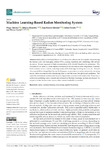Mostrar o rexistro simple do ítem
Machine Learning-Based Radon Monitoring System
| dc.contributor.author | Valcarce, Diego | |
| dc.contributor.author | Alvarellos, Alberto | |
| dc.contributor.author | Rabuñal, Juan R. | |
| dc.contributor.author | Dorado, Julián | |
| dc.contributor.author | Gestal, M. | |
| dc.date.accessioned | 2022-07-14T17:42:25Z | |
| dc.date.available | 2022-07-14T17:42:25Z | |
| dc.date.issued | 2022 | |
| dc.identifier.citation | Valcarce, D.; Alvarellos, A.; Rabuñal, J.R.; Dorado, J.; Gestal, M. Machine Learning-Based Radon Monitoring System. Chemosensors 2022, 10, 239. https://doi.org/10.3390/chemosensors10070239 | es_ES |
| dc.identifier.uri | http://hdl.handle.net/2183/31186 | |
| dc.description.abstract | [Abstract] Radon (Rn) is a biological threat to cells due to its radioactivity. It is capable of penetrating the human body and damaging cellular DNA, causing mutations and interfering with cellular dynamics. Human exposure to high concentrations of Rn should, therefore, be minimized. The concentration of radon in a room depends on numerous factors, such as room temperature, humidity level, existence of air currents, natural grounds of the buildings, building structure, etc. It is not always possible to change these factors. In this paper we propose a corrective measure for reducing indoor radon concentrations by introducing clean air into the room through forced ventilation. This cannot be maintained continuously because it generates excessive noise (and costs). Therefore, a system for predicting radon concentrations based on Machine Learning has been developed. Its output activates the fan control system when certain thresholds are reached. | es_ES |
| dc.description.sponsorship | This work is supported by Instituto de Salud Carlos III, grant number PI17/01826 Collaborative Project in Genomic Data Integration (CICLOGEN) funded by the Instituto de Salud Carlos III from the Spanish National Plan for Scientific and Technical Research and Innovation 2013–2016 and the European Regional Development Funds (FEDER)— “A way to build Europe.” This project was also supported by the General Directorate of Culture, Education and University Management of the Xunta de Galicia ED431D 2017/16, the “Drug Discovery Galician Network” Ref. ED431G/01, and the “Galician Network for Colorectal Cancer Research” (Ref. ED431D 2017/23). This work was also funded by the grant for the consolidation and structuring of competitive research units (ED431C 2018/49) from the General Directorate of Culture, Education and University Management of the Xunta de Galicia, and the CYTED network (PCI2018 093284) funded by the Spanish Ministry of Innovation and Science. This project was also supported by the General Directorate of Culture, Education and University Management of the Xunta de Galicia “PRACTICUM DIRECT” Ref. IN845D-2020/03 | es_ES |
| dc.description.sponsorship | Xunta de Galicia; ED431D 2017/16 | es_ES |
| dc.description.sponsorship | Xunta de Galicia; ED431G/01 | es_ES |
| dc.description.sponsorship | Xunta de Galicia; ED431D 2017/23 | es_ES |
| dc.description.sponsorship | Xunta de Galicia; ED431C 2018/49 | es_ES |
| dc.description.sponsorship | Xunta de Galicia; IN845D-2020/03 | es_ES |
| dc.language.iso | eng | es_ES |
| dc.publisher | MDPI | es_ES |
| dc.relation.uri | https://doi.org/10.3390/chemosensors10070239 | es_ES |
| dc.rights | Atribución 4.0 Internacional | es_ES |
| dc.rights.uri | http://creativecommons.org/licenses/by/4.0/ | * |
| dc.subject | Radon | es_ES |
| dc.subject | Machine learning | es_ES |
| dc.subject | Monitoring | es_ES |
| dc.subject | Applied biosensing | es_ES |
| dc.title | Machine Learning-Based Radon Monitoring System | es_ES |
| dc.type | journal article | es_ES |
| dc.rights.accessRights | open access | es_ES |
| UDC.journalTitle | Chemosensors | es_ES |
| UDC.volume | 10 | es_ES |
| UDC.issue | 7 | es_ES |
| UDC.startPage | 239 | es_ES |
| dc.identifier.doi | 10.3390/chemosensors10070239 | |
| UDC.coleccion | Investigación | es_ES |
| UDC.departamento | Ciencias da Computación e Tecnoloxías da Información | es_ES |
| UDC.grupoInv | Redes de Neuronas Artificiais e Sistemas Adaptativos -Informática Médica e Diagnóstico Radiolóxico (RNASA - IMEDIR) | es_ES |
| UDC.grupoInv | Laboratorio de Enxeñaría do Software (ISLA) | es_ES |
| dc.relation.projectID | info:eu-repo/grantAgreement/ISCIII/Plan Estatal de Investigación Científica y Técnica y de Innovación 2013–2016/PI17%2F01826/ES/PROYECTO COLABORATIVO DE INTEGRACION DE DATOS GENOMICOS (CICLOGEN). TECNICAS DE DATA MINING Y DOCKING MOLECULAR PARA ANALISIS DE DATOS INTEGRATIVOS EN CANCER DE COLON/ | |
| dc.relation.projectID | info:eu-repo/grantAgreement/AEI/Plan Estatal de Investigación Científica y Técnica y de Innovación 2017-2020/PCI2018-093284/ES/OBESIDAD Y DIABETES EN IBEROAMERICA: FACTORES DE RIESGO Y NUEVOS BIOMARCADORES PATOGENICOS Y PREDICTIVOS/ |
Ficheiros no ítem
Este ítem aparece na(s) seguinte(s) colección(s)
-
Investigación (FIC) [1678]






